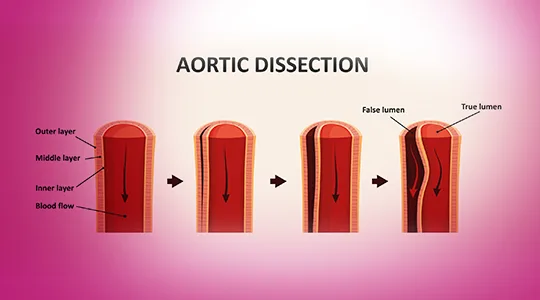Abdominal Aortic Aneurysm Symptoms
- Pulsatile abdominal masses: The aneurysm can be identified with physical examinations, as a round tumor located at the umbilical, or the upper left of the umbilical, the mass can be found pulsating at a rate that is consistent with the heartbeat.
- Pain: The aneurysm can compress and erode vertical body, causing pain at the nerve root of the abdomen and/or the lower back. Sudden sharp abdominal pain is often the precursor of rapid expansion or even rupture of the aneurysm.
- Sense of Compression: Compression of surrounding organs can result into associated symptoms, such as upper abdominal fullness, urinary system obstruction, etc.
- Embolism: The blood clot in the aneurism often falls off, and rushes to the peripheral circulation systems, resulting in arterial embolism at the lower extremity, leading to limb ischemia and necrosis
- Hemorrhage: The most serious clinical threat of this disease, manifested as sudden severe abdominal pain, hemorrhagic shock and pulsatile abdominal mass.

Diagnosis
- Ultrasound: The ultrasound could detect abdominal aortic aneurysms with a diameter of greater than 3 cm, and whether there are plaques or blood clots present.
- CT (computer tomography): Plain and enhanced CT scan could accurately display the shape of the aneurysm and adjacent relationship with surrounding organs. The scan could also help physicians to judge whether there are anatomical abnormalities, and identify whether there are other abdominal diseases. The Spiral CT three-dimensional reconstruction technology (3DCTA) can accurately display the three dimensional morphology, size and degree of seriousness of the affected abdominal aortic branches, as well as measure the parameter of the various parts of the aneurysm.
- MR angiography: Angiography can show the location, size and shape of aneurysm without the need for contrasting agent, and can provide vivid images of the aneurysm. Angiograph can provide high diagnostic value for subacute and chronic hematoma caused by aneurysm rupture.
- DSA (digital subtraction angioplasty): DSA can provide important value in the diagnosis of thoracoabdominal aortic aneurysm, multiple aneurysm and aortic dissection. However the true size of the aneurysm may not be displayed when there is a large number of blood clots within the aneurysm.

Therapeutic solutions: Endovascular Aortic Repair
Endovascular Aortic Repair (EVAR) is an alternative to open surgery and has the advantage of less trauma, faster recovery, fewer complications and fewer contra-indications. During EVAR, under the constant monitoring of DSA, a folded metal scaffold covered with artificial vascular membrane is delivered into the abdominal aorta through the bilateral common femoral artery approach, and then placed into the aneurysm cavity according to the stent positioning set before operation. The stent is fixed onto the artery wall near and distal to the aneurysm by using the self-expanding property of the metal scaffold and the barb on the bare segment of the scaffold (to withstand the impact of high pressure blood flow on the aortic wall). Then, the aortic wall of the aneurysm and stent membrane form blood thrombosis and structure, this achieves the purpose of isolating the aneurysm and treating the disease.


